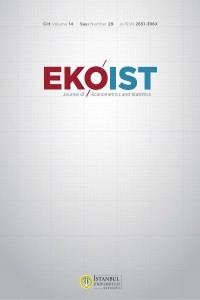AN EMPIRICAL MODEL FOR THE TURKISH TRADE BALANCE: NEW EVIDENCE FROM ARDL BOUNDS TESTING ANALYSES
Bu çalışmada Türk ticaret dengesinin belirleyicileri uygulamalı bir modelleme yaklaşımı içerisinde çözümlenmeye çalışılmaktadır. Bu amaçla çağdaş ARDL temelli sınırlar testi ilgi alanımıza giren değişkenler arasındaki uzun dönemli eş-bütünleşik bir ilişkinin varlığının incelenmesi için kullanılmıştır. Tahmin sonuçları reel döviz kuru değer kayıplarının ticaret dengesini güçlü ve anlamlı bir şekilde iyileştirdiğini, yurtiçi reel gelirin ticaret dengesini negatif olarak etkilediğini ve ticaret dengesinin yabancı reel gelirdeki bir artış sonucu güçlü bir şekilde iyileştiğini göstermektedir. Ham petrol fiyatlarının ticaret dengesi üzerinde anlamlı bir etkisi gözlenememektedir. Hata düzeltme modellemesi eş-bütünleşim çözümlemesinin uzun dönem bulguları doğrultusunda sonuçlar vermektedir.
Anahtar Kelimeler:
Ticaret Dengesi, ARDL Sınırlar Testi Yaklaşımı, Türkiye Ekonomisi
AN EMPIRICAL MODEL FOR THE TURKISH TRADE BALANCE: NEW EVIDENCE FROM ARDL BOUNDS TESTING ANALYSES
In this paper, the determinants of the Turkish trade balance are tried to be analyzed in an empirical modelling approach. For this purpose, the contemporaneous ARDL-based bounds testing has been used to examine the existence of a long run co-integration relationship between the variables of our interest. The estimation results indicate that real exchange rate depreciations improves the trade balance in a strong and significant way, that domestic real income affects the trade balance negatively, and that trade balance is strongly improved due to an increase in foreign real income. No significant effect of crude oil prices can be observed on trade balance. The error correction modeling gives results in line with the long run findings of the co integration analysis.
Keywords:
Trade Balance ARDL Bounds Testing Approach, Approach, Turkish Economy,
___
- Akbostancı, E. 2004. Dynamics of the Trade Balance: The Turkish J-Curve. Emerging Markets Finance and Trade 40: 57-73.
- Aydın, M.F., Çıplak, U. and Yücel, M.E. 2004. Export Supply and Import Demand Models for the Turkish Economy. CBRT Research Department Discussion Paper, No. 04/09.
- Bahmani-Oskooee, M. 1991. Is There a Long-Run Relation Between the Trade Balance and the Real Effective Exchange Rate of LDCs?. Economic Letters, 36: 403-407.
- Bahmani-Oskooee, M. 2001. Nominal and Real Effective Exchange Rates of Middle Eastern Countries and Their Trade Performance. Applied Economics 33: 103-111.
- Bårdsen, G. 1989. Estimation of Long Run Coefficients in Error Correction Models. Oxford Bulletin of Economics and Statistics 51(2): 345-350.
- Berument, H. and Dinçer, N. 2005. Denomination Composition of Trade and Trade Balance: Evidence from Turkey. Applied Economics 37: 1177-191.
- Brada, J. C., Kutan, A.M. and Zhou, S. 1997. The Exchange Rate and the Balance of Trade: The Turkish Experience. The Journal of Development Studies, June, 33: 675-692.
- Dickey, D.A. and Fuller, W.A. 1979. Distribution of the Estimators for Autoregressive Time Series with a Unit Root. Journal of the American Statistical Association 74: 427-431.
- Dickey, D.A. and Fuller, W.A. 1981. Likelihood Ratio Statistics for Autoregressive Time Series with Unit Roots. Econometrica 49: 1057-1072.
- Domaç, İ. 1993. The J-Curve Phenomenon and Its Existence in Turkey. Yapı Kredi Economic Review, January, 6: 65-80.
- Engle, R.F. and Granger, C.W.J. 1987. Co-integration and Error Correction: Representation, Estimation, and Testing. Econometrica 55: 251-276.
- Goldstein, M. and Khan, M.S. 1985. Income and Price Effects in Foreign Trade. in Ronald W. Jones and Peter B. Kenen (eds.), Handbook of International Economics, Vol. 2, Amsterdam: North Holland, 1041-1105.
- Göktaş, Ö. 2005. Teorik ve Uygulamalı Zaman Serileri Analizi. İstanbul: Beşir Kitabevi.
- Granger, C.W.J. and Newbold, P. 1974. Spurious Regressions in Economics. Journal of Econometrics 2(2): 111-120.
- http://www.dpt.gov.tr/.
- http://www.oecd.org.
- http://www.tcmb.gov.tr.
- International Monetary Fund. International Financial Statistics. Various Issues.
- Johansen, S. 1988. Statistical Analysis of Cointegration Vectors. Journal of Economic Dynamics and Control 12: 231-254.
- Johansen, S. 1995. Likelihood-based Inference in Co-integrated Vector Autoregressive Models. Oxford University Press.
- Johansen, S. and Juselius, K. 1990. Maximum Likelihood Estimation and Inference on Cointegration-with Applications to the Demand for Money. Oxford Bulletin of Economics and Statistics 52: 169-210.
- Kale, P. 2001. Turkey’s Trade Balance in the Short and the Long Run: An Error Correction Modeling and Cointegration. The International Trade Journal 1(1): 27-55.
- Kwiatkowski, D., Phillips, P.C.B., Schmidt, P., and Shin, Y. 1992. Testing the Null Hypothesis of Stationary against the Alternative of a Unit Root. Journal of Econometrics 54: 159-178.
- Kotan, Z. and Saygılı, M. 1999. Estimating An Import Function for Turkey. CBRT Research Department Discussion, No. 9909.
- Nemlioğlu, A.K. 2005, Birim Kök Analizinin Temelleri, İstanbul: Beşir Kitabevi.
- Pesaran, M.H., and Shin, Y. 1999. An Autoregressive Distributed Lag Modelling Approach to Cointegration Analysis. Chapter 11 in Econometrics and Economic Theory in the 20th Century: The Ragnar Frisch Centennial Symposium, Strom S.(ed.), Cambridge: Cambridge University Press.
- Pesaran, M.H, Shin, Y. and Smith, R.J. 2001. Bound Testing Approaches to the Analysis of Level Relationships. Journal of Applied Econometrics 16: 289-326.
- Rose, A.K. 1990. Exchange Rates and the Trade Balance: Some Evidence from Developing Countries. Economics Letters, 34(3): 271-275.
- Rose, A.K. and Yellen, J.L. (1989). Is There a J-curve. Journal of Monetary Economics 24(1): 53-68.
- Stučka, T. 2004. The Effects of Exchange Rate Change on the Trade Balance in Croatia. IMF Working Paper, April, No. 04/65.
- Şahinbeyoğlu, G. and Ulaşan, B. 1999. An Empirical Examination of the Structural Stability of Export Function: The Case of Turkey. CBRT Research Department Discussion Paper, No. 9907.
- Yavuz, N.Ç. 2004. Durağanlığın Belirlenmesinde KPSS ve ADF Testleri: İMKB Ulusal-100 Endeksi ile bir Uygulama. İ.Ü. İktisat Fakültesi Mecmuası 54(1): 239-247.
- Yavuz, N.Ç. and Güriş, B. 2006. An Aggregate Import Demand Function for Turkey: The Bounds Testing Approach. METU Studies in Development, December, 33: 311-325.
- Zortuk, M. and Durman, M. 2008. Testing the Relationship between Trade Balance and Terms of Trade: The Case of Turkey. Problems and Perspectives in Management 6(2): 39-43.
- Yayın Aralığı: Yılda 2 Sayı
- Yayıncı: İstanbul Üniversitesi
